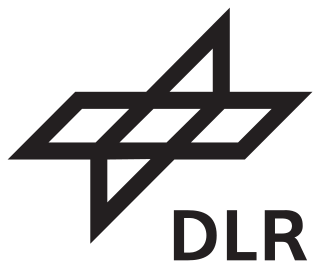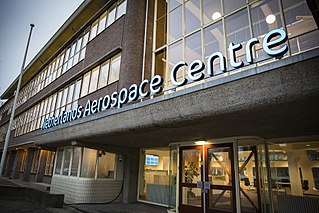
A flight simulator is a device that artificially re-creates aircraft flight and the environment in which it flies, for pilot training, design, or other purposes. It includes replicating the equations that govern how aircraft fly, how they react to applications of flight controls, the effects of other aircraft systems, and how the aircraft reacts to external factors such as air density, turbulence, wind shear, cloud, precipitation, etc. Flight simulation is used for a variety of reasons, including flight training, the design and development of the aircraft itself, and research into aircraft characteristics and control handling qualities.

Aerospace is a term used to collectively refer to the atmosphere and outer space. Aerospace activity is very diverse, with a multitude of commercial, industrial and military applications. Aerospace engineering consists of aeronautics and astronautics. Aerospace organizations research, design, manufacture, operate, or maintain both aircraft and spacecraft.

An aviation accident is defined by the Convention on International Civil Aviation Annex 13 as an occurrence associated with the operation of an aircraft, which takes place from the time any person boards the aircraft with the intention of flight until all such persons have disembarked, and in which a) a person is fatally or seriously injured, b) the aircraft sustains significant damage or structural failure, or c) the aircraft goes missing or becomes completely inaccessible. Annex 13 defines an aviation incident as an occurrence, other than an accident, associated with the operation of an aircraft that affects or could affect the safety of operation.

Transport in Europe provides for the movement needs of over 700 million people and associated freight.

The German Aerospace Center, abbreviated DLR, is the national center for aerospace, energy and transportation research of Germany, founded in 1969. It is headquartered in Cologne with 35 locations throughout Germany. The DLR is engaged in a wide range of research and development projects in national and international partnerships. DLR also acts as the German space agency and is responsible for planning and implementing the German space programme on behalf of the German federal government. As a project management agency, DLR coordinates and answers the technical and organisational implementation of projects funded by a number of German federal ministries.

The Civil Aviation Authority (CAA) is the statutory corporation which oversees and regulates all aspects of civil aviation in the United Kingdom. Its areas of responsibility include:

The European Union Aviation Safety Agency (EASA) is an agency of the European Union (EU) with responsibility for civil aviation safety. It carries out certification, regulation and standardisation and also performs investigation and monitoring. It collects and analyses safety data, drafts and advises on safety legislation and co-ordinates with similar organisations in other parts of the world.

The European Organisation for the Safety of Air Navigation, commonly known as Eurocontrol, is an international organisation working to achieve safe and seamless air traffic management across Europe. Founded in 1960, Eurocontrol currently has 41 member states and is headquartered in Brussels, Belgium. It has several local sites as well, including an Innovation Hub in Brétigny-sur-Orge, France, the Aviation Learning Centre (ALC) in Luxembourg, and the Maastricht Upper Area Control Centre (MUAC) in Maastricht, the Netherlands. The organisation employs approximately two thousand people, and operates with an annual budget in excess of half a billion Euro.

The Royal Netherlands Aerospace Centre, formerly known as the National Aerospace Laboratory is an aerospace research organization of the Netherlands and is one of its major technological institutes. These institutes perform a large part of the applied research in the Netherlands, each within its own specific field of technology. As an independent non-profit organization, the NLR is the aerospace-knowledge enterprise in the Netherlands and provides technical support to the aerospace sector.
European Business Aviation Association or EBAA, is a non-profit association based in Belgium established in 1977. Containing 684 member companies, spreading to all aspects in the aviation business sector of Europe and worldwide. The EBAA's main goal is to promote excellence from professionalism among its members, to ensure that aviation business is properly recognized as a vital sector of the European Economy. EBAA represents operators from different categories corporate, commercial, manufacturers, airports, fixed-base operators, also provide business aviation services.

General aviation (GA) has been defined as a civil aircraft operation other than a commercial air transport flight operating to a schedule. Although the International Civil Aviation Organization (ICAO) excludes any form of remunerated aviation from its definition, some commercial operations are often included within the scope of General Aviation (GA). General aviation refers to all flights other than military and scheduled airline flights, both private and commercial.
Korea Aerospace University is a private university located in Goyang, Gyeonggi, South Korea.
A civil aviation authority (CAA) is a national or supranational statutory authority that oversees the regulation of civil aviation, including the maintenance of an aircraft register.

Civil Aerospace Medical Institute (CAMI) is the medical certification, education, research, and occupational medicine wing of the Office of Aerospace Medicine (AAM) under the auspices of the Federal Aviation Administration Office of Aviation Safety. The Institute's primary goal is to enhance aviation safety.
Manchester Metropolitan University's Centre for Aviation, Transport and the Environment (CATE) is an international research centre based at the Dalton Research Institute specialising in the environmental impacts of the aviation industry.
Urban Air Mobility (UAM) is the use of small, highly automated aircraft to carry passengers or cargo at lower altitudes in urban and suburban areas which have been developed in response to traffic congestion. It usually refers to existing and emerging technologies such as traditional helicopters, vertical-takeoff-and-landing aircraft (VTOL), electrically propelled, vertical-takeoff-and-landing aircraft (eVTOL), and unmanned aerial vehicles (UAVs). These aircraft are characterized by the use of multiple electric-powered rotors or fans for lift and propulsion, along with fly-by-wire systems to control them. Inventors have explored urban air mobility concepts since the early days of powered flight. However, advances in materials, computerized flight controls, batteries and electric motors improved innovation and designs beginning in the late 2010s. Most UAM proponents envision that the aircraft will be owned and operated by professional operators, as with taxis, rather than by private individuals.
The NITROS project is an ongoing project which began in November 2016 consisting of 12 Early Stage Researchers (ESRs). It is funded through the European Union's Marie Skłodowska-Curie Actions (MSCA) research grant which is an Innovative Training Network (ITN) to support European Joint Doctorates (EJD). The collective aim of this specific MSCA scheme is for fostering new skills by means of excellent initial training of researchers.

The Boeing 737 MAX was initially certified in 2017 by the U.S. Federal Aviation Administration (FAA) and the European Union Aviation Safety Agency (EASA). Global regulators grounded the plane in 2019 following fatal crashes of Lion Air Flight 610 and Ethiopian Airlines Flight 302. Both crashes were linked to the Maneuvering Characteristics Augmentation System (MCAS), a new automatic flight control feature. Investigations in both crashes determined that Boeing and the FAA favored cost-saving solutions, but ultimately produced a flawed design of the MCAS instead. The FAA's Organization Designation Authorization program, allowing manufacturers to act on its behalf, was also questioned for weakening its oversight of Boeing.

The European Helicopter Safety Team (EHEST) was a European aviation safety improvement initiative focusing on improving helicopter safety in Europe and worldwide. It was established in 2006 as part of the European Strategic Safety Initiative (ESSI) of the European Aviation Safety Agency (EASA). The goal of the European Helicopter Safety Team was to contribute to reducing the worldwide helicopter accident rate by 80% in the time-span 2006-2016, which was set as a goal by the International Helicopter Safety Team (IHST) in 2006. Focusing on European helicopter operators and manufacturers, the European Helicopter Safety Team conducted helicopter accident analyses, provided technology potential studies, and published safety management and training documents.











